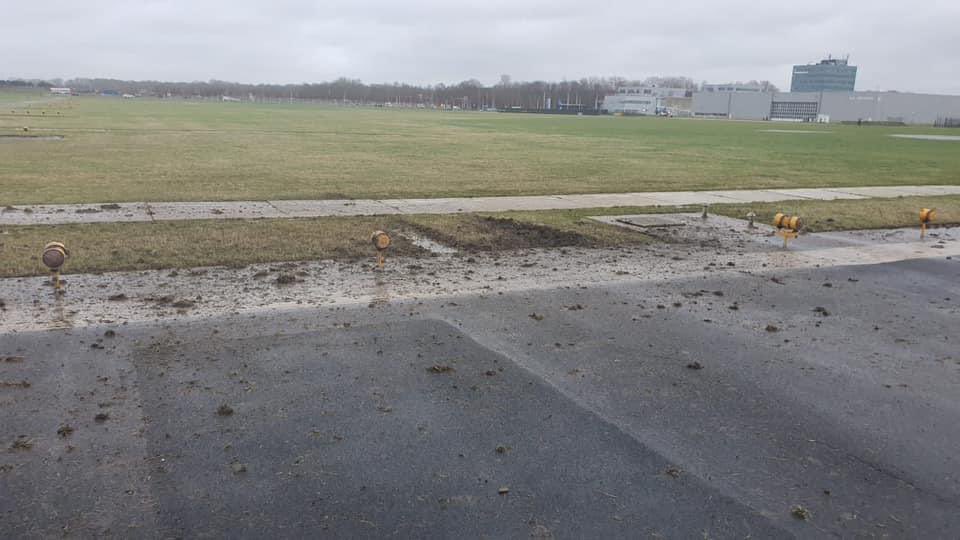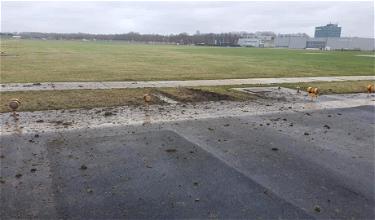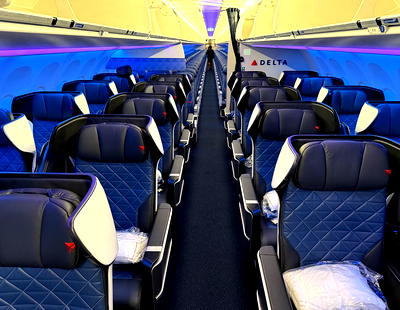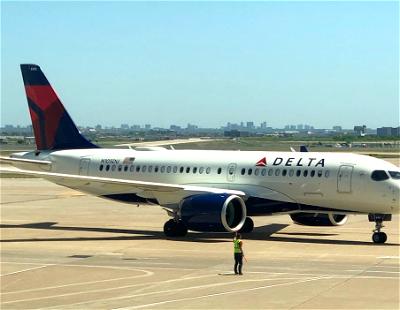While this is probably a case of “all’s well that ends well,” this is still a pretty noteworthy incident, as reported by The Aviation Herald.
In this post:
Delta plane lands six feet short of Amsterdam runway
This incident involves a nearly 20-year-old Delta Air Lines Airbus A330-300 with the registration code N802NW. The plane operated DL134 from Detroit (DTW) to Amsterdam (AMS), departing on the evening of January 11, and landing on the morning of January 12.
The plane was coming in to land at Schiphol Airport, and was assigned runway 22, which is 6,627 feet long — that’s the shortest runway at the airport. With good weather conditions, this runway wouldn’t ordinarily be used for jets this size. However, winds at the time were 27 knots and gusting to 38 knots, and the winds were almost a direct headwind for the runway, which is why this was being used for many arrivals.
Unfortunately at 7:52AM local time, the aircraft’s main landing gear touched down ahead of the paved surface of the runway, in the grass. This was roughly six feet ahead of the start of the paved runway. It’s also worth clarifying that the pilots weren’t just six feet off here with their landing — the “aiming point” for landing is quite a bit further down the runway.
This landing caused damage to two runway threshold lights. Fortunately no one was injured, and the plane rolled out without further incident and taxied to its gate.
The runway was closed for around an hour following the incident, for repairs to the runway lights to take place. Dutch investigators are now examining the incident. I’m curious what comes of the investigation — what caused the pilots to touch down so early, and should they have accepted this runway assignment?
Below you can see a picture that shows where the plane touched down.

The A330 will be ferried back to the United States
The Airbus A330 involved in this incident was supposed to operate Thursday’s Amsterdam to Boston flight, DL259. That flight ended up being canceled.

Instead the current plan is for the plane to be ferried back to the United States this afternoon. Specifically, the plane is expected to be flown to Minneapolis (presumably for maintenance) at 4PM on Friday, as DL9936. It’ll be interesting to see how quickly this plane is back in service.
Bottom line
A Delta Airbus A330 touched down in the grass at Amsterdam Schiphol Airport, just six feet short of the start of the runway. The plane was landing on a short runway in not ideal weather conditions, but of course that doesn’t excuse or explain what happened.
While some runway lights were taken out, fortunately it seems the plane hasn’t sustained major damage, and no one was hurt. I imagine this could have ended very differently if the plane had touched down even earlier.
What do you make of this Delta landing incident?




I fly airbuses; that first comment is totally inaccurate. Of course you can hand fly an airbus to a landing. In gusts, you *should* be hand flying. But even if you kept the automation loaded up, you’re just 2 quick clicks away from having total control. Either way, you’re responsible for the safe operation of the aircraft, and putting the mains in the dirt isn’t excusable.
There's a lot of 'talk' here about letting the tech do the work of flying/landing the plane
but on a different day
there'd be a lot of talk about why pilots make errors when the tech fails
& they actually HAVE to fly the plane.???
AFAIA pilots hand fly the take off & landing usually supported by the autothrottle system.?
& most of what's in between is done by the autopilot system
...There's a lot of 'talk' here about letting the tech do the work of flying/landing the plane
but on a different day
there'd be a lot of talk about why pilots make errors when the tech fails
& they actually HAVE to fly the plane.???
AFAIA pilots hand fly the take off & landing usually supported by the autothrottle system.?
& most of what's in between is done by the autopilot system
Also
doesn't the Airbus landing assistance system have software which defines whether the aircraft is configured to land on a given length of runway.?
If the plane thought the runway was too short
it would have told the cockpit crew
very loudly.!!!
A lot of overthinking going on here. This is simply pilot error. Landing a large aircraft on a short runway, and being concerned about stopping on the runway.
Landing data either says you can use the runway or you can’t. No additional “techniques” are needed.
A 330 at max landing weight can land and stop in less than 5000’
A few comments in response to previous ones, yes the the Bus has a lot of automation, but there is nothing to preclude landing it manual under those conditions, in fact I would say the vast majority of the landings in the Airbus are manual. Auto landings are normally accomplished in low visibility approaches, Cat 2/Cat 3.
Auto thrust can be engaged under the gusty conditions, it will hunt as someone said previously, depending...
A few comments in response to previous ones, yes the the Bus has a lot of automation, but there is nothing to preclude landing it manual under those conditions, in fact I would say the vast majority of the landings in the Airbus are manual. Auto landings are normally accomplished in low visibility approaches, Cat 2/Cat 3.
Auto thrust can be engaged under the gusty conditions, it will hunt as someone said previously, depending if you are using managed speed vs selected speed. In managed speed you get ground speed mini protection which keeps the aircraft energy level at a steady state accounting for gusts and headwind/tailwind conditions. Any aircraft can be a handful in gusty conditions.
At this point we need to wait until the report is issued to find out what happened.
Tim Dunn says it's the runways fault.
Hi guys,the list of it could have been this or that is as long as a your "arm" .weather,mechanical failure,pilot error,or a combination of any of the above. E.g. weather;could be windshear,severe downdrafts. Mechanical failure; faulty radio altimeter,engines almost at flight idle,so unable to spool up to reverse a rapid decrease in airspeed,( In very windy gusty conditions,we don't use auto throttle because it tends to " hunt" the desired airspeed).Pilot Error; just good old...
Hi guys,the list of it could have been this or that is as long as a your "arm" .weather,mechanical failure,pilot error,or a combination of any of the above. E.g. weather;could be windshear,severe downdrafts. Mechanical failure; faulty radio altimeter,engines almost at flight idle,so unable to spool up to reverse a rapid decrease in airspeed,( In very windy gusty conditions,we don't use auto throttle because it tends to " hunt" the desired airspeed).Pilot Error; just good old fashioned misjudgement . Just some examples from the various categories. However until the Digital Flight Data Recorders are decoded,we won't know.
As an aside, the threshold lights are frangible,designed to break on impact with an aircraft, to lessen damage they can
cause.Also someone quoted the A330's approach speed as 137kts.It is not a fixed number,weight, altitude & temperature & wind determines approach speed.
Cheers
KJ - thanks for the reply and added insight to the A330 and VApp speed.
For those interested here is a very long and interesting article into landing and it’s approach from airbus itself. It’s absolutely aimed at pilots, so non-pilots may have a difficult time.
It also explains the calculations that go into the VApp speed.
https://safetyfirst.airbus.com/control-your-speed-during-descent-approach-and-landing/
Also to add, runway 22 at AMS has a PAPI - which gives the PF a good visual indication of their position in the glide path.
I don’t do any ILS or GPS approaches - but I would assume once good visual contact with the runway is made that visual landing systems, such as a PAPI, would be used to confirm the approach as well as the instruments?
Knucklehead (pilot) error!!
An airbus most certainly can be hand flown (and nearly always is) to a normal landing. This is likely an error due to the apprehension of landing on a short runway. Probably “ducked under” the glide path a bit; and got a nasty surprise.
Jason
A320 / 321 CA
The A330 is a handful to fly and land with those kind of headwinds. Technically, you cannot fully manually land the aircraft under these conditions.
Big downdraft on short final
Shit happens.
@Ben, quite unrelated to this topic, but it might interest you (maybe as a two in one): Condor seems to be going with Air Belgium as an upcoming lease partner, after some issue with their current wet lease:
https://www.aerotelegraph.com/so-erklaert-smart-lynx-den-chaotischen-punta-cana-flug
The YouTube video you've linked isn't actually this landing. Sunrise in Amsterdam was ~8:46AM yesterday and the landing happened at 7:52 (when it would have still been dark). (AVHerald initially had that same video linked, but they've also pulled it after realizing it wasn't the correct landing.)
@ Jefferson -- Good catch, thank you. Updated the post to reflect that.
Isn't it about time we automate all these things and leave human error out of the equation.
We have all the technologies available over the counter, but a bunch of Regulatorsaurus who are buddies with Unionosaurus aren't extinct yet.
It's likely your automation was partly to blame. The Airbus is fly-by-wire and it cannot be completely hand flown to a landing. 27kts gusting to 35 is a very strong headwind but also very variable. If the wind suddenly dropped 10kts as they approached the threshold, the aircraft would suddenly lose a portion of it's lift, causing it to drop. Interesting they are flying the aircraft half way around the world for repair. That might...
It's likely your automation was partly to blame. The Airbus is fly-by-wire and it cannot be completely hand flown to a landing. 27kts gusting to 35 is a very strong headwind but also very variable. If the wind suddenly dropped 10kts as they approached the threshold, the aircraft would suddenly lose a portion of it's lift, causing it to drop. Interesting they are flying the aircraft half way around the world for repair. That might indicate a software concern rather than mechanical.
"it cannot be completely hand flown to a landing"
Is exactly where the automation is missing.
Unless 27kts gusting to 35 is blowing on your face, then you are seeing what other instruments are already seeing, at least milliseconds before you even start to react.
And unless "hand flown" is literally like a child holding a toy plane flying around. Every input you give, can be given by a computer, even if the wind suddenly...
"it cannot be completely hand flown to a landing"
Is exactly where the automation is missing.
Unless 27kts gusting to 35 is blowing on your face, then you are seeing what other instruments are already seeing, at least milliseconds before you even start to react.
And unless "hand flown" is literally like a child holding a toy plane flying around. Every input you give, can be given by a computer, even if the wind suddenly dropped 10kts. Again milliseconds before you even start to react.
Your defenses is exactly what 'flight engineers' claimed could not be done.
Interesting they are flying the aircraft half way around the world for repair. That might indicate a mechanical concern rather than software. But then again the whole system is managed by Corporatesaurases.
“The end is inevitable. Your kind is destined for extinction"
Mayor Pete: Maybe So, But Not Today.
Fly by wire does not exclude a manual landing. All fly by wire means is that the pilot makes inputs into the controls and the aircraft’s computer then decides what control surfaces to move to execute the desired result from the input.
Additionally, as noted by Ben, the aircraft was short of the entire runway, not just the landing point. The desired touchdown point was 1000 feet from the threshold of the runway as...
Fly by wire does not exclude a manual landing. All fly by wire means is that the pilot makes inputs into the controls and the aircraft’s computer then decides what control surfaces to move to execute the desired result from the input.
Additionally, as noted by Ben, the aircraft was short of the entire runway, not just the landing point. The desired touchdown point was 1000 feet from the threshold of the runway as there is no displaced threshold on runway 22 at AMS. There also does not appear to be any obstructions requiring a steep approach, and this runway has very little if any slope.
Per Airbus the flair should start at 40 ft AGL in an A330. This should only occur at or past the threshold. The A330 has a VApp speed of 137kts. It’s doubtful that a 10kt change in headwind would cause an A330 to miss the landing point by 1000 feet short or drop 40 feet suddenly to the ground.
A wrong altimeter setting may cause something like this in a GA aircraft with automation but no radar altimeter. I wouldn’t expect that to be an issue in the A330 which has a radar altimeter.
Perhaps a microburst? Those are generally associated with thunderstorms, but don’t have to be.
My only mildly informed opinion as a GA pilot with no specific knowledge of this case beyond what is presented here - it’s likely pilot error.
@a Pilot
Ever heard of “groundspeed mini”? An Airbus feature that negates your theory.
False, you can hand fly the airplane all the way to the ground.
Can you update your name to “a pilot who has clearly never flown an airbus” please?
Airbus close to landing fully automated passenger jets
https://www.theregister.com/2023/01/13/airbus_future_technologies_subsidiary_wants/
@XPL
Garmin did it years ago.
"We have all the technologies available over the counter."
If my $300 game console can handle very complex flight sim dynamics at home with ease, I'm sure a multi million dollar aircraft equipment is more than capable of making precision flying possible today.
@Eskimo
If you saw the crazy cockups the A320 can get itself into in fully managed (automated) modes you’d think differently!
It can definitely be done remotely and automated. 20something kids in a warehouse in north dakota remotely can fly a 20million dollar drone in afghanistan, drop some million dollar bombs on poppy farmers, then land it at the 10billion dollar air force base back in kabul all while dodging bullets from taliban fighters using the guns they stole from american military. Pretty sure a plane can land at a commercial airport all by itself.
In this case it sounds like any damage is likely limited to the rear landing gear (it looks a bit "wobbly" when it hits the dirt). I would assume that it's safe to fly, the concern has to do with a fully loaded landing. There may also be a concern about retracting the gear after take-off.
I would assume the plane would have a cursory inspection at AMS just to see if the landing gear can at least properly retract and extend, then a more comprehensive inspection would occur in Minneapolis.
Couldn't their best buddy KLM perform the comprehensive inspection?
I'm sure if they can service their own A330, they could fix their best buddy too.
I've always been curious about piloting these ferry flights, because isn't the airline essentially saying "We aren't certain these planes are airworthy, who wants to volunteer to find out?"
Not necessarily. I've ferried airplanes many times at my airline and sometimes it is just for positioning because the A/C is needed elsewhere, or it was at a maintenance base doing routine maintenance, or it's a new airplane that is being delivered...many reasons. But yea, if it's been involved in an incident it would be ferried to a major maintenance base to be checked out.
There is a difference between safe to fly and legally airworthy.
A missing "No Smoking in Lavatory” placards?
I believe that's one of the requirements to make it airworthy.
When you're ferrying you're carrying a lot less weight, and in the still extremely unlikely event something does happen the only people are the professional and well-trained pilots at the front of the plane, so there's no potential evacuation of the masses that has to be accomplished. (2 professional pilots having to belly land an empty plane much less of a big deal than doing the same with a plane fill if people.)
It looks like the aircraft has no big issue. According to flightradar24 it is scheduled to operate DL1301 tomorrow morning 6am. The ferry flight AMS-MSP will not arrive before 8pm tonight. So yes, there is a night stop which allows for some maintenance, but definitely not any major repair.
Just an update on my own post. The plane finally did not depart as a ferry flight to MSP, yesterday. Therefore, it does also not operate DL1301 today.
Instead it should be ferried to ATL today, Saturday afternoon.